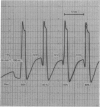Abstract
1. The blood flow through the forearm was measured 2 sec after single, brief isometric hand-grip contractions. The tension and duration of those contractions varied from 10 to 100% of the maximal voluntary contraction (m.v.c.) and from 2 to 12 sec, respectively. 2. The blood flow increased linearly with tension up to about 60% m.v.c. but further increases in tension, up to 100% m.v.c., did not elicit higher blood flows than were found at 60% m.v.c. The same relationship between tension and the resultant blood flow held for all durations of contractions, from 2 to 12 sec. The blood flow immediately after (2 sec) contractions at a given tension increased linearly with the duration of the contraction, from 2 to 12 sec. Maximal exercise blood flow was approached only in response to the longest contractions (12 sec) at tensions of 60% m.v.c. or higher. 3. Brief alterations (2--5 sec) of transmural pressure across blood vessels did not result in a significant change of blood flow, either in the resting forearm or when the vessels were dilated by brief, isometric contractions. When the tension was applied or released either rapidly or gradually ('ramp' contractions) there was no correlation between the rate of change of stretch on arterial vessels and the resultant blood flow. However, there was a direct relationship between a force--time integral (duration of contraction x peak tension) and blood flow. All these results make it clear that changes in blood flow in the forearm elicited by brief isometric contractions are not the result of a myogenic reflex but are metabolically induced. 4. Successive contractions exerted at 60% m.v.c. for 4 sec induced a blood flow of 21.2 +/- 1.6 ml.min-1.100 ml.-1 when a rest interval of 8 sec was allowed between the contractions. Blood flows remained constant at this submaximal level, even when muscular fatigue was induced, and when there was an accompanying large increase in blood pressure. 5. Isometric muscular activity by the contralateral arm which resulted in fatigue, associated with a large increase in mean blood pressure, did not alter the level of vasodilation that was induced by brief, isometric contractions in the 'test' arm. 6. It is suggested that the vasodilatation in response to intermittent isometric contractions is the result of metabolic vasodilatation of distal segments and continued sympathetic vasoconstriction of the proximal segments of the forearm vascular bed.
Full text
PDF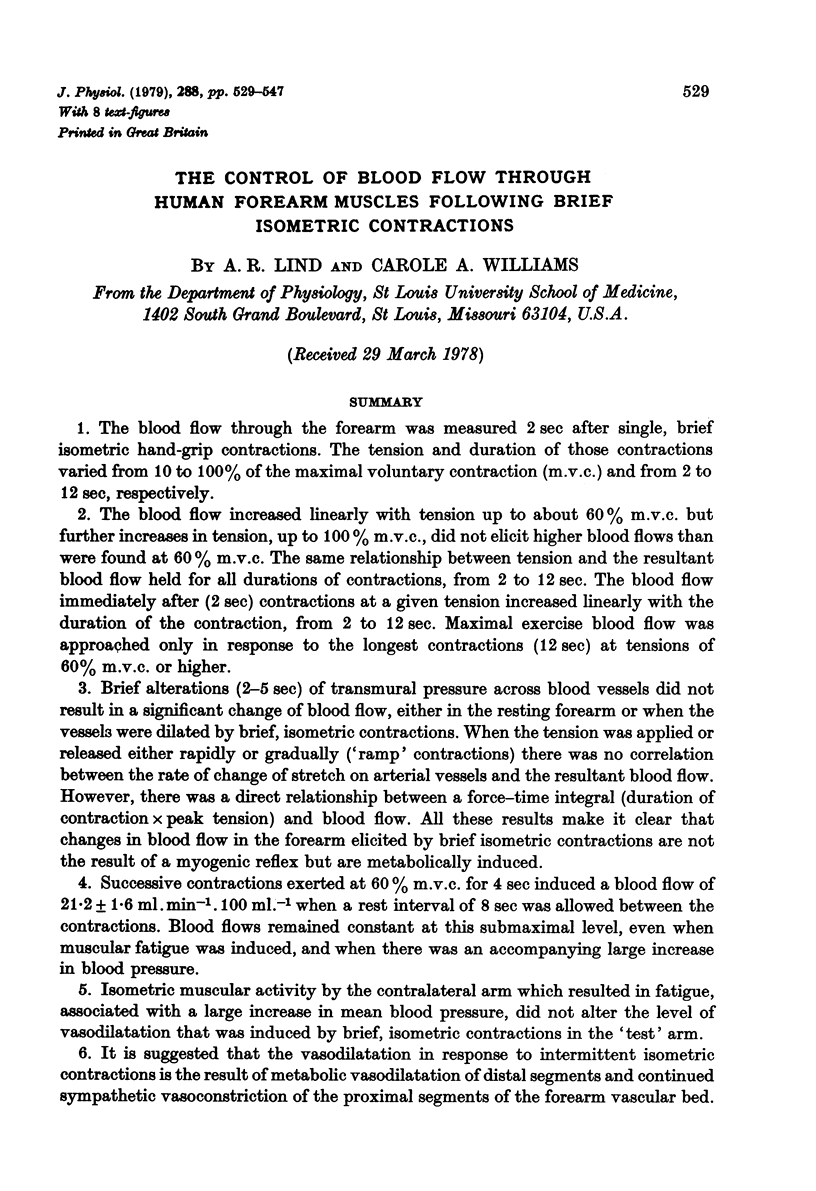
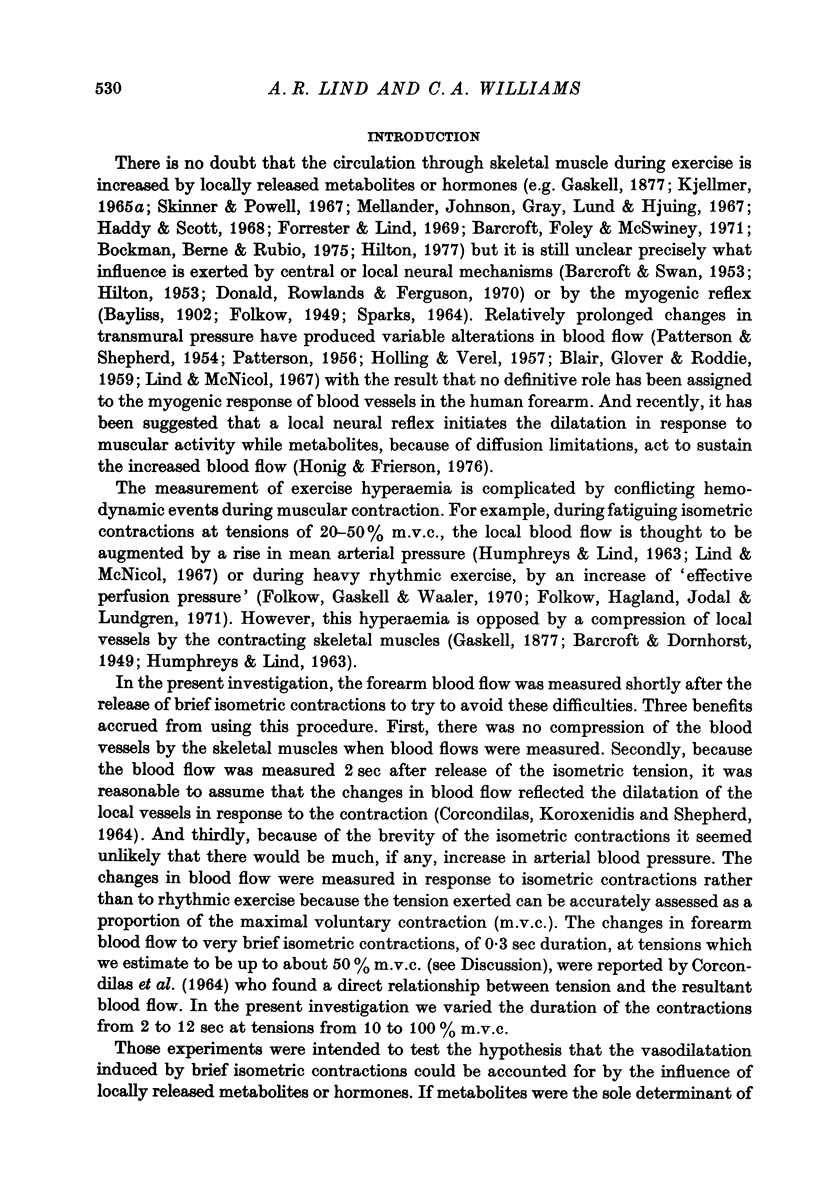
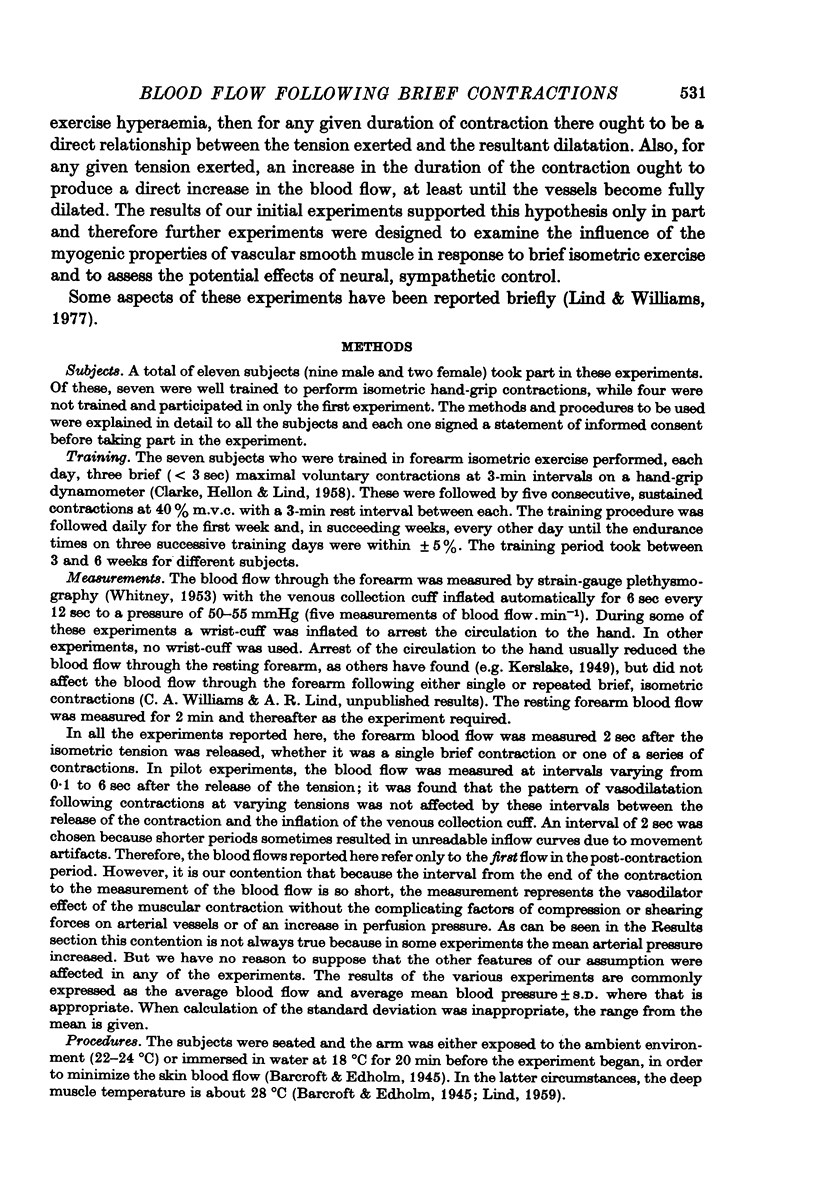

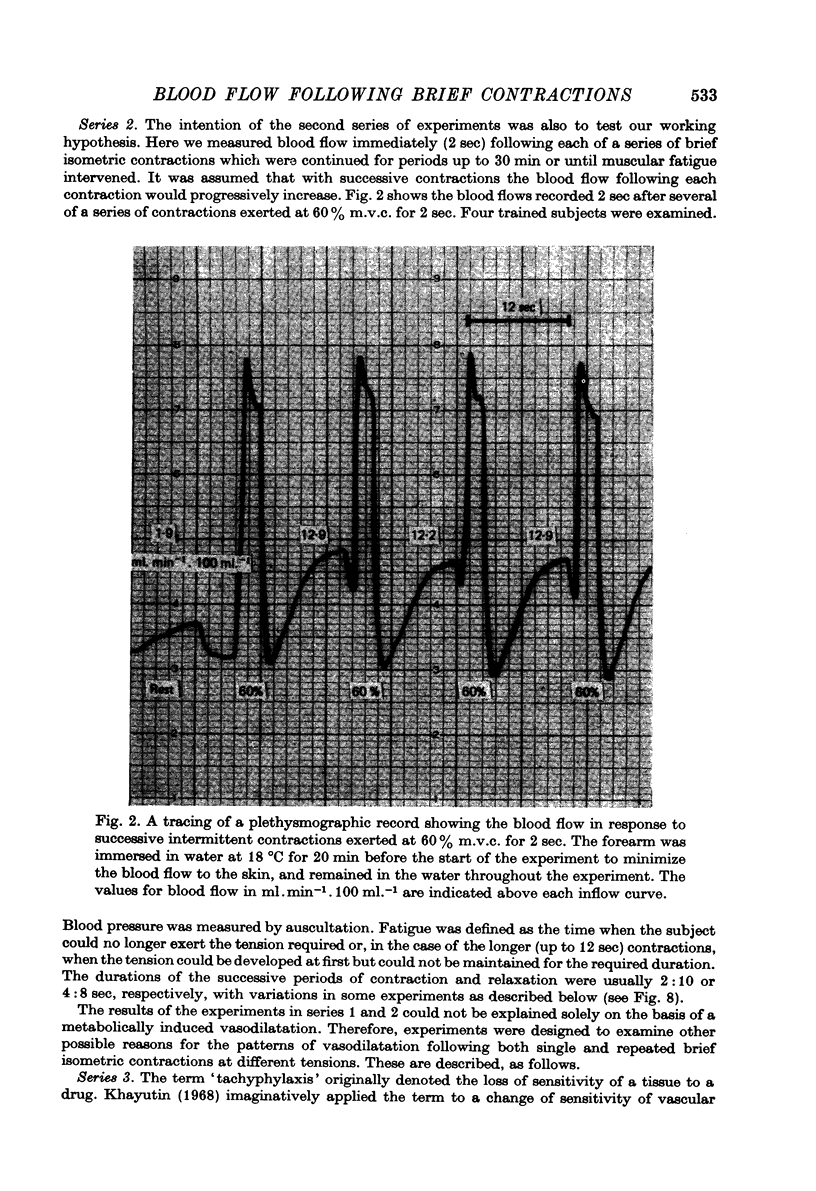


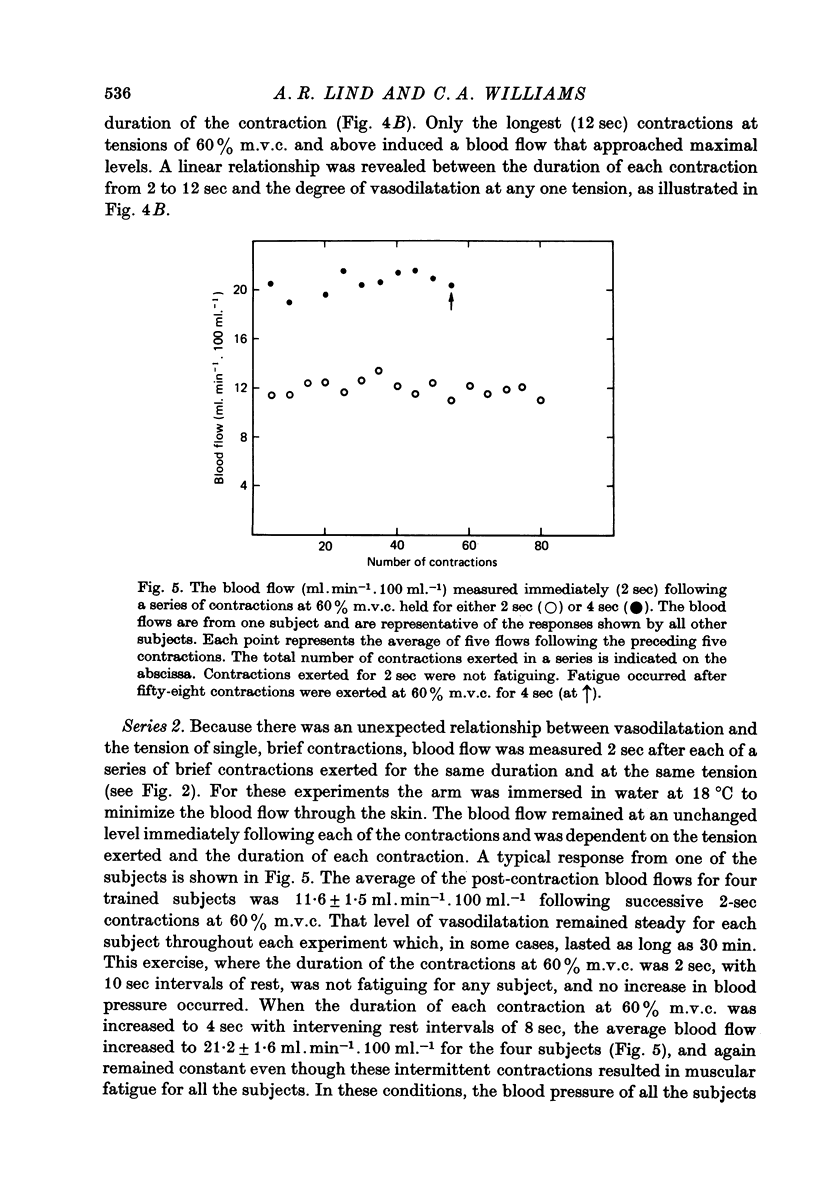

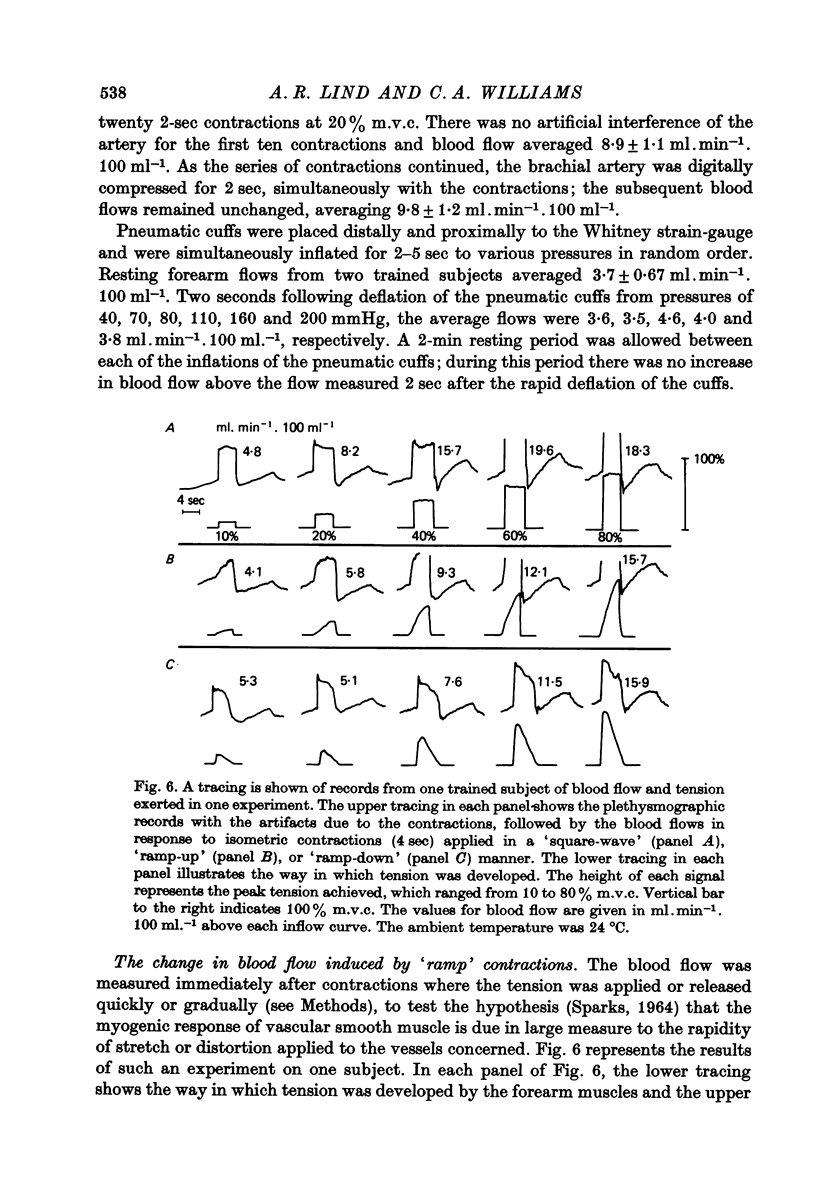
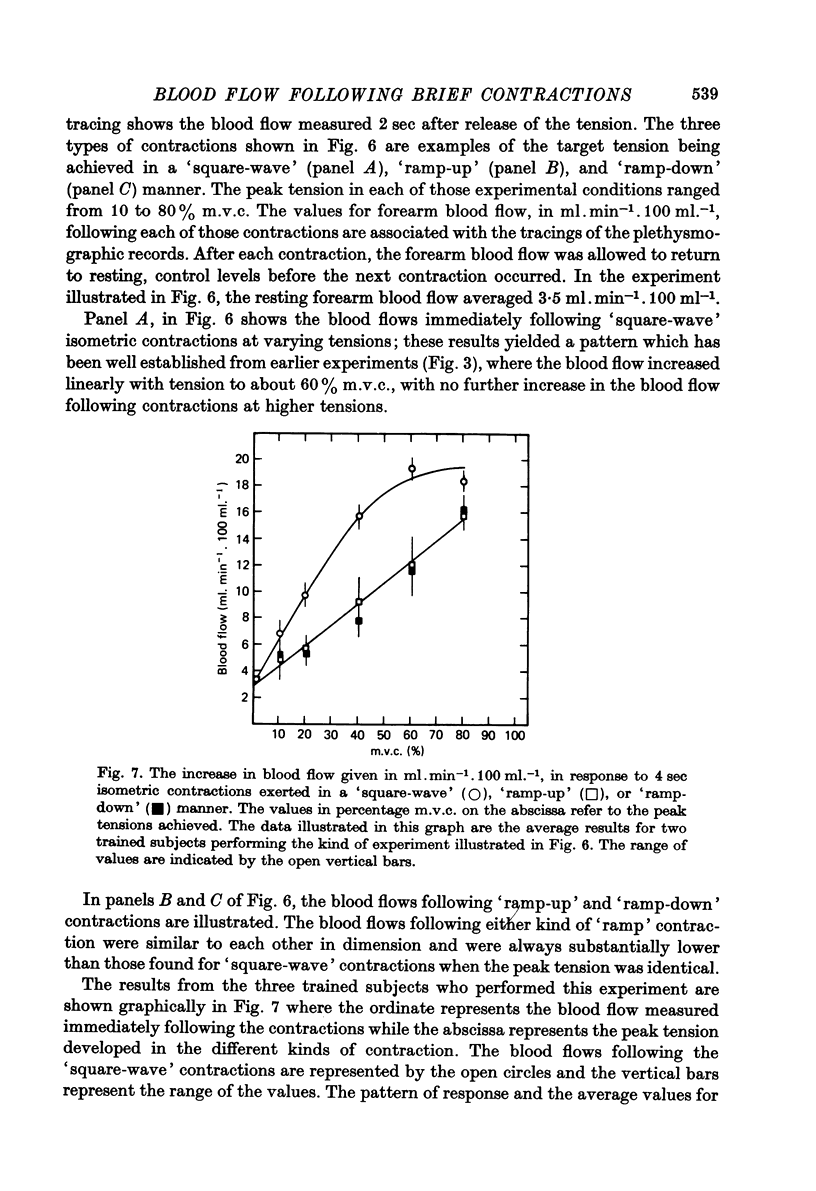
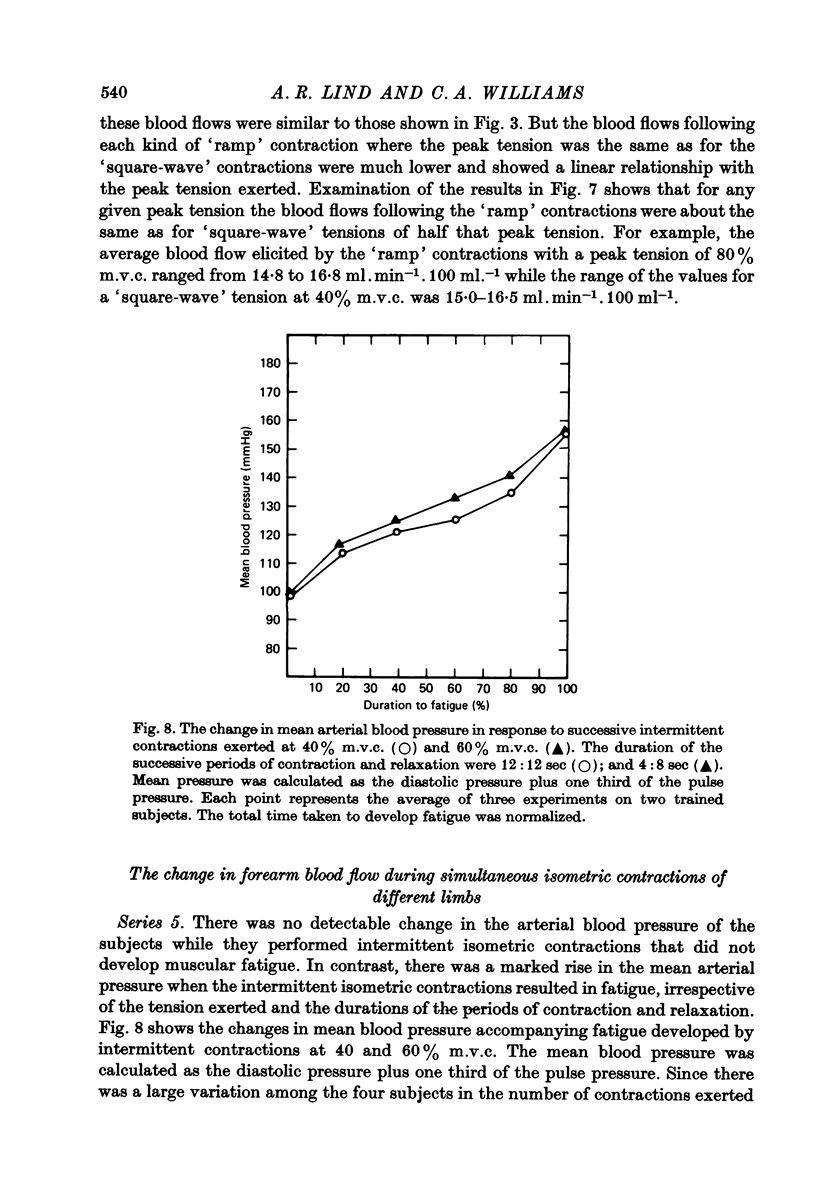

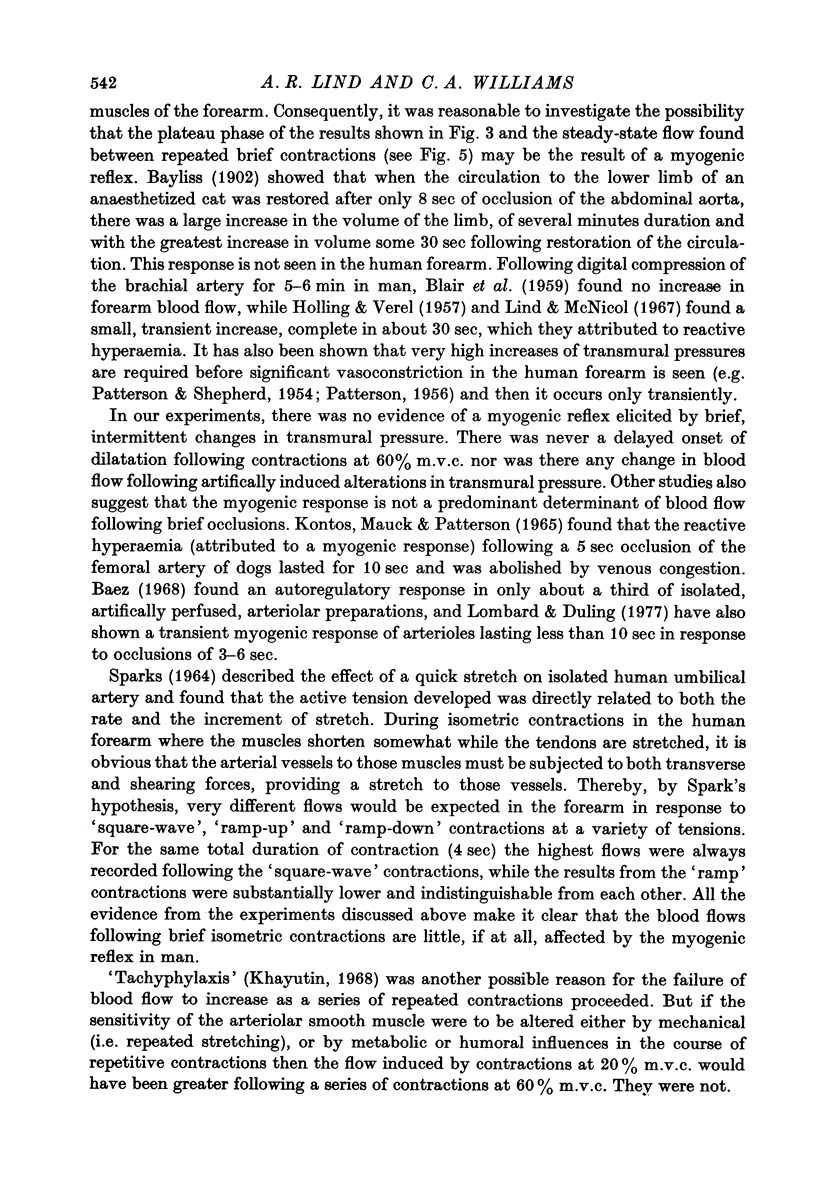
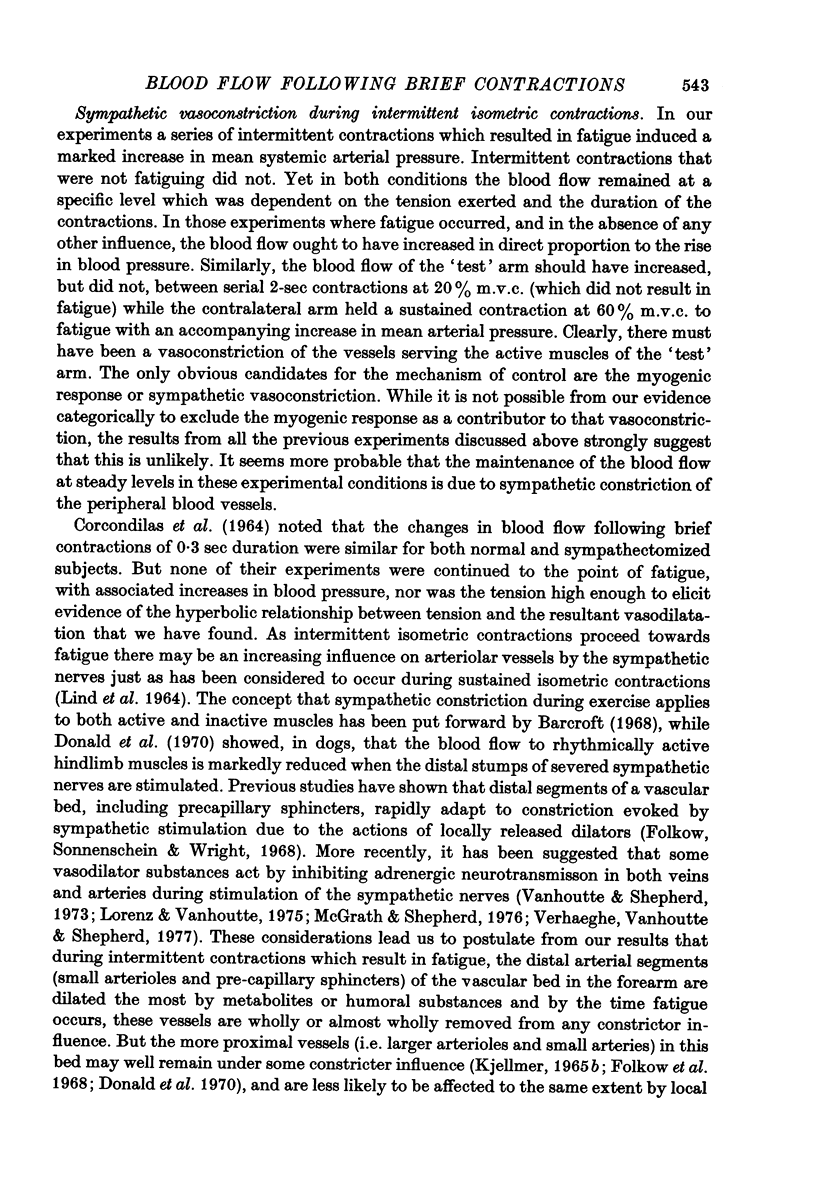
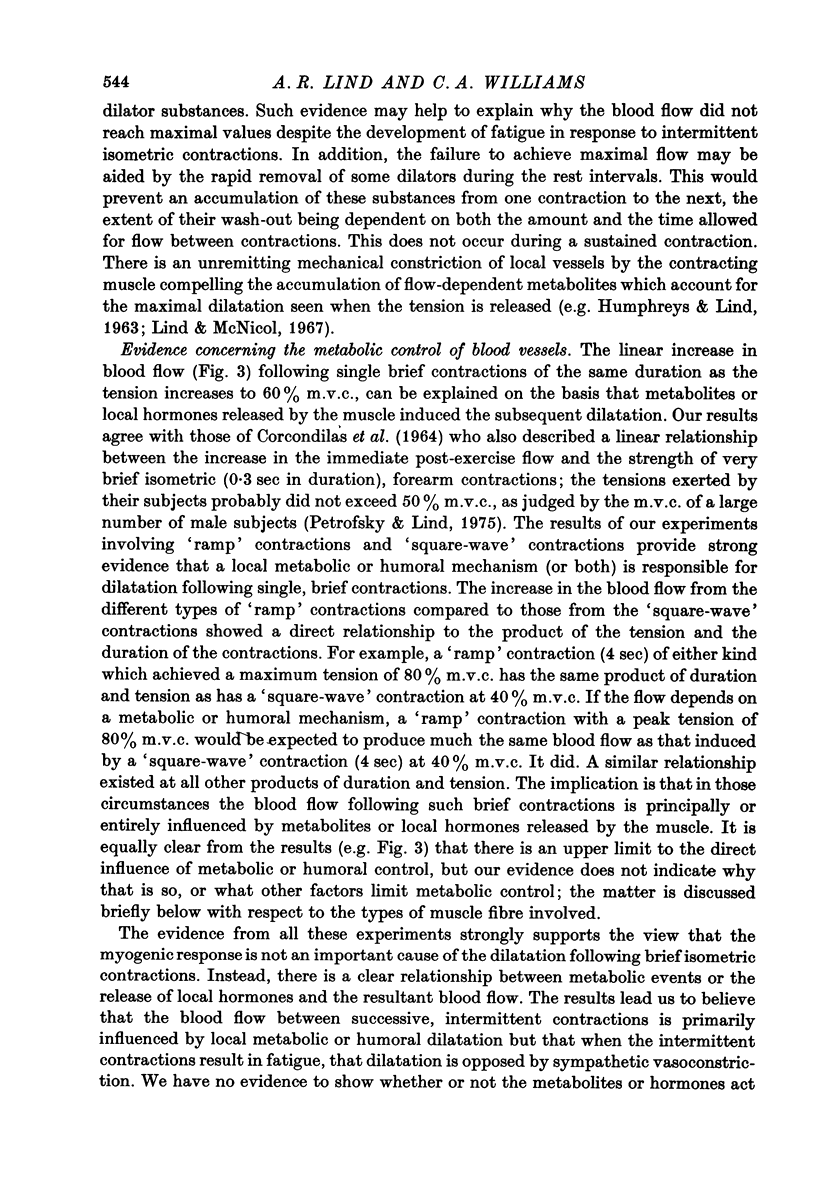


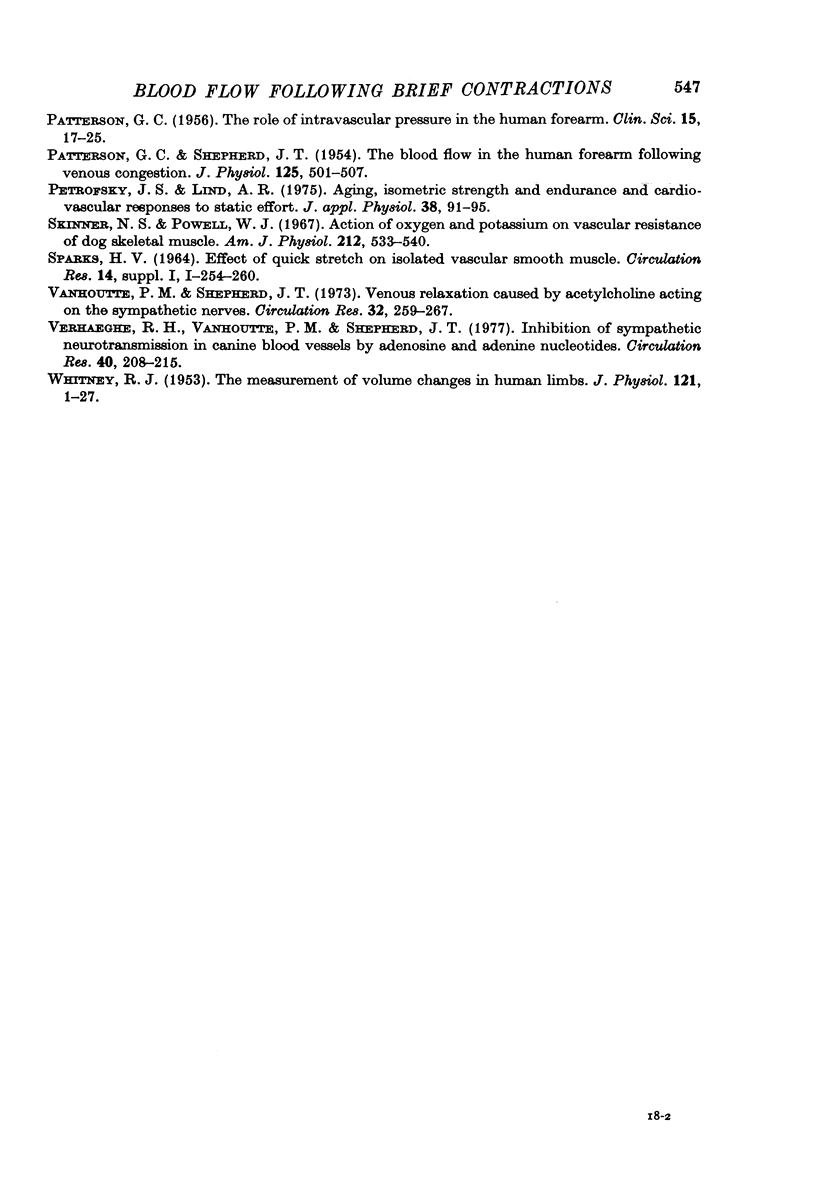
Images in this article
Selected References
These references are in PubMed. This may not be the complete list of references from this article.
- BARCROFT H., DORNHORST A. C. The blood flow through the human calf during rhythmic exercise. J Physiol. 1949 Sep;109(3-4):402-11, pl. doi: 10.1113/jphysiol.1949.sp004403. [DOI] [PMC free article] [PubMed] [Google Scholar]
- Baez S. Bayliss response in the microcirculation. Fed Proc. 1968 Nov-Dec;27(6):1410–1415. [PubMed] [Google Scholar]
- Barcroft H., Foley T. H., McSwiney R. R. Experiments on the liberation of phosphate from the muscles of the human forearm during vigorous exercise and on the action of sodium phosphate on forearm muscle blood vessels. J Physiol. 1971 Mar;213(2):411–420. doi: 10.1113/jphysiol.1971.sp009390. [DOI] [PMC free article] [PubMed] [Google Scholar]
- Barcroft H., Millen J. L. The blood flow through muscle during sustained contraction. J Physiol. 1939 Nov 14;97(1):17–31. doi: 10.1113/jphysiol.1939.sp003789. [DOI] [PMC free article] [PubMed] [Google Scholar]
- Bayliss W. M. On the local reactions of the arterial wall to changes of internal pressure. J Physiol. 1902 May 28;28(3):220–231. doi: 10.1113/jphysiol.1902.sp000911. [DOI] [PMC free article] [PubMed] [Google Scholar]
- Bockman E. L., Berne R. M., Rubio R. Release of adenosine and lack of release of ATP from contracting skeletal muscle. Pflugers Arch. 1975 Mar 26;355(3):229–241. doi: 10.1007/BF00583686. [DOI] [PubMed] [Google Scholar]
- CLARKE R. S., HELLON R. F., LIND A. R. The duration of sustained contractions of the human forearm at different muscle temperatures. J Physiol. 1958 Oct 31;143(3):454–473. doi: 10.1113/jphysiol.1958.sp006071. [DOI] [PMC free article] [PubMed] [Google Scholar]
- CORCONDILAS A., KOROXENIDIS G. T., SHEPHERD J. T. EFFECT OF A BRIEF CONTRACTION OF FOREARM MUSCLES ON FOREARM BLOOD FLOW. J Appl Physiol. 1964 Jan;19:142–146. doi: 10.1152/jappl.1964.19.1.142. [DOI] [PubMed] [Google Scholar]
- Donald D. E., Rowlands D. J., Ferguson D. A. Similarity of blood flow in the normal and the sympathectomized dog hind limb during graded exercise. Circ Res. 1970 Feb;26(2):185–199. doi: 10.1161/01.res.26.2.185. [DOI] [PubMed] [Google Scholar]
- Folkow B., Gaskell P., Waaler B. A. Blood flow through limb muscles during heavy rhythmic exercise. Acta Physiol Scand. 1970 Sep;80(1):61–72. doi: 10.1111/j.1748-1716.1970.tb04770.x. [DOI] [PubMed] [Google Scholar]
- Folkow B., Haglund U., Jodal M., Lundgren O. Blood flow in the calf muscle of man during heavy rhythmic exercise. Acta Physiol Scand. 1971 Feb;81(2):157–163. doi: 10.1111/j.1748-1716.1971.tb04887.x. [DOI] [PubMed] [Google Scholar]
- Funderburk C. F., Hipskind S. G., Welton R. C., Lind A. R. Development of and recovery from fatigue induced by static effort at various tensions. J Appl Physiol. 1974 Sep;37(3):392–396. doi: 10.1152/jappl.1974.37.3.392. [DOI] [PubMed] [Google Scholar]
- HILTON S. M. Experiments on the post contraction hyperaemia of skeletal muscle. J Physiol. 1953 Apr 28;120(1-2):230–245. doi: 10.1113/jphysiol.1953.sp004888. [DOI] [PMC free article] [PubMed] [Google Scholar]
- HOLLING H. E., VEREL D. Circulation in the elevated forearm. Clin Sci. 1957 May;16(2):197–213. [PubMed] [Google Scholar]
- HUMPHREYS P. W., LIND A. R. The blood flow through active and inactive muscles of the forearm during sustained hand-grip contractions. J Physiol. 1963 Apr;166:120–135. doi: 10.1113/jphysiol.1963.sp007094. [DOI] [PMC free article] [PubMed] [Google Scholar]
- Haddy F. J., Scott J. B. Metabolically linked vasoactive chemicals in local regulation of blood flow. Physiol Rev. 1968 Oct;48(4):688–707. doi: 10.1152/physrev.1968.48.4.688. [DOI] [PubMed] [Google Scholar]
- Hilton S. M. Evidence for phosphate as a mediator of functional hyperaemia in skeletal muscles. Pflugers Arch. 1977 Jun 8;369(2):151–159. doi: 10.1007/BF00591571. [DOI] [PubMed] [Google Scholar]
- Honig C. R., Frierson J. L. Neurons intrinsic to arterioles initiate postcontraction vasodilation. Am J Physiol. 1976 Feb;230(2):493–507. doi: 10.1152/ajplegacy.1976.230.2.493. [DOI] [PubMed] [Google Scholar]
- KJELLMER I. ON THE COMPETITION BETWEEN METABOLIC VASODILATATION AND NEUROGENIC VASOCONSTRICTION IN SKELETAL MUSCLE. Acta Physiol Scand. 1965 Apr;63:450–459. doi: 10.1111/j.1748-1716.1965.tb04088.x. [DOI] [PubMed] [Google Scholar]
- KJELLMER I. THE POTASSIUM ION AS A VASODILATOR DURING MUSCULAR EXERCISE. Acta Physiol Scand. 1965 Apr;63:460–468. doi: 10.1111/j.1748-1716.1965.tb04089.x. [DOI] [PubMed] [Google Scholar]
- Kontos H. A., Mauck H. P., Jr, Patterson J. L., Jr Mechanism of reactive hyperemia in limbs of anesthetized dogs. Am J Physiol. 1965 Dec;209(6):1106–1114. doi: 10.1152/ajplegacy.1965.209.6.1106. [DOI] [PubMed] [Google Scholar]
- LIND A. R. Muscle fatigue and recovery from fatigue induced by sustained contractions. J Physiol. 1959 Jun 23;147(1):162–171. doi: 10.1113/jphysiol.1959.sp006231. [DOI] [PMC free article] [PubMed] [Google Scholar]
- LIND A. R., TAYLOR S. H., HUMPHREYS P. W., KENNELLY B. M., DONALD K. W. THE CIRCULATIORY EFFECTS OF SUSTAINED VOLUNTARY MUSCLE CONTRACTION. Clin Sci. 1964 Oct;27:229–244. [PubMed] [Google Scholar]
- Lind A. R., McNicol G. W. Local and central circulatory responses to sustained contractions and the effect of free or restricted arterial inflow on post-exercise hyperaemia. J Physiol. 1967 Oct;192(3):575–593. doi: 10.1113/jphysiol.1967.sp008318. [DOI] [PMC free article] [PubMed] [Google Scholar]
- Lind A. R., Williams C. A. Changes in the forearm blood flow following brief isometric hand-grip contractions at different tensions [proceedings]. J Physiol. 1977 Oct;272(1):97P–98P. [PubMed] [Google Scholar]
- Lombard J. H., Duling B. R. Relative contributions of passive and myogenic factors to diameter changes during single arteriole occlusion in the hamster cheek pouch. Circ Res. 1977 Sep;41(3):365–373. doi: 10.1161/01.res.41.3.365. [DOI] [PubMed] [Google Scholar]
- Lorenz R. R., Vanhoutte P. M. Inhibition of adrenergic neurotransmission in isolated veins of the dog by potassium ions. J Physiol. 1975 Mar;246(2):479–500. doi: 10.1113/jphysiol.1975.sp010900. [DOI] [PMC free article] [PubMed] [Google Scholar]
- McGrath M. A., Shepherd J. T. Inhibition of adrenergic neurotransmission in canine vascular smooth muscle by histamine: mediation by H2-receptors. Circ Res. 1976 Oct;39(4):566–573. doi: 10.1161/01.res.39.4.566. [DOI] [PubMed] [Google Scholar]
- Mellander S., Johansson B., Gray S., Jonsson O., Lundvall J., Ljung B. The effect of hyperosmolarity on intacet and isolated vascular smooth muscle. Possible role in exercise hyperemia. Angiologica. 1967;4(6):310–322. doi: 10.1159/000157715. [DOI] [PubMed] [Google Scholar]
- Mohrman D. E., Sparks H. V. Role of potassium ions in the vascular response to a brief tetanus. Circ Res. 1974 Sep;35(3):384–390. doi: 10.1161/01.res.35.3.384. [DOI] [PubMed] [Google Scholar]
- PATTERSON G. C., SHEPHERD J. T. The blood flow in the human forearm following venous congestion. J Physiol. 1954 Sep 28;125(3):501–507. doi: 10.1113/jphysiol.1954.sp005176. [DOI] [PMC free article] [PubMed] [Google Scholar]
- Petrofsky J. S., Lind A. R. Aging, isometric strength and endurance, and cardiovascular responses to static effort. J Appl Physiol. 1975 Jan;38(1):91–95. doi: 10.1152/jappl.1975.38.1.91. [DOI] [PubMed] [Google Scholar]
- Skinner N. S., Jr, Powell W. J., Jr Action of oxygen and potassium on vascular resistance of dog skeletal muscle. Am J Physiol. 1967 Mar;212(3):533–540. doi: 10.1152/ajplegacy.1967.212.3.533. [DOI] [PubMed] [Google Scholar]
- Vanhoutte P. M., Shepherd J. T. Venous relaxation caused by acetylcholine acting on the sympathetic nerves. Circ Res. 1973 Feb;32(2):259–267. doi: 10.1161/01.res.32.2.259. [DOI] [PubMed] [Google Scholar]
- Verhaeghe R. H., Vanhoutte P. M., Shepherd J. T. Inhibition of sympathetic neurotransmission in canine blood vessels by adenosine and adenine nucleotides. Circ Res. 1977 Feb;40(2):208–215. doi: 10.1161/01.res.40.2.208. [DOI] [PubMed] [Google Scholar]
- WHITNEY R. J. The measurement of volume changes in human limbs. J Physiol. 1953 Jul;121(1):1–27. doi: 10.1113/jphysiol.1953.sp004926. [DOI] [PMC free article] [PubMed] [Google Scholar]




